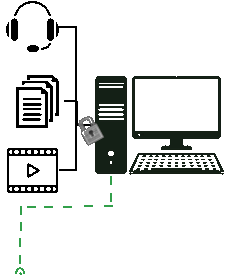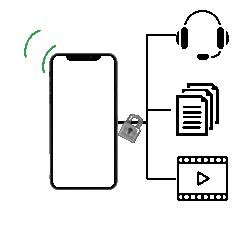MCx a new standard within Critical Communication
MCx is a new standard defined by 3GPP, where x does stand for several mission critical (mc) services like PTT (push to talk, meaning voice), data, video and other services. The standard is defined to run as well on LTE 4G and 5G systems. Data throughput rate in legacy critical communication systems has been considered to be too small, since video and data transmission becomes a constantly growing demand in also within critical communication. MCx serves this purpose and includes voice services as well.
MC-Data, MC-Video, Mc-PTT or other MCx services via desktop or mobile applications


Interworking Function (IWF)
Integration of 4G or 5G networks with TETRA, P25 or other LMR systems will be possible thanks to the ETSI defined IWF (interworking function) on the Mission Critial application server. The mission Critical application server is connected to a specific APN or DNN of the mobile (private) network core. The IWF does on IP level connect with the lagacy narrow band infrastructure. Hereby allowing cross communication for voice and short massages between LMR system and 4G or 5G networks.
Public or private infrastructure
MCx services can be integrated into standard public mobile LTE networks or the infrastructure can be privately owned as well. Biggest challenge for 3GPP during their standardisation process therefore was the priority level of each service. While in earlier times online gaming did have a very high priority level, meanwhile MCx services in the current available releases are higher rated. Thanks to this fact, service availability in public networks is always guaranteed, if coverage and thereby sufficient throughput for data is available.
This has been a big difficulty in the past, since commercially for any telco providers these MCx services are paid with low cost and low amount of users, but they require large investments into coverage, redundancy, level of throughput and several more. Coverage typically is great within cities, due to the population and mobile network user amount. Anyhow critical communication services are of equal importance inside buildings or tunnels as well as in rural areas.
Users may benefit from using one single device for any service, if that device is sufficiently secured. If coverage is available, it basically has no distance limits. Frequency planning and costs can also be saved, while “only” MCx application servers must be inserted (cloud based solution) into the network, which may come at different cost levels. But be aware with this type of network usage you are dependent on network providers coverage, maintenance cycles, redundancy options and several other schedules.
Running such a MCx service set on a private LTE or private 5G network surely has infrastructure costs and frequency licensing issues, but once overcome you are in full control of services, priorities, interoperability as well as of redundancy and coverage. Private Mobile Networks (MPN) which are also often abbreviated P5G (private 5G) are becomming more and more affordable and spectrum available.
Differences to PoC (Push to Talk over cellular)
The main difference between MCx and POC is that PoC is based on proprietary solutions, which typically do not interoperate with any other manufacturer. In such cases the benefits of priorities within a cellular network is not differentiated for the different services and typically a standard data bearer on a constant priority level is used. Servers and clients products in a PoC case typically belong to the same manufacturer and additional clients or other services will have to be purchased at the same manufacturer. When being in full control over your network infrastructure, backbone and traffic model, this service can be sufficient for several installations. How reliable the service is able to operate will be dependent on the use case and should be analysed individually. Typically PoC services are significantly cheaper than MCx services.
MCx status and outlook
There are several installations across various industries and nations in the market. When MCx standardisation was started, it has been predicted to take over all public safety networks quite quickly within several years. Today most of the networks are hybrid installations, where a Tetra, DMR or P25 system is running in parallel to an LTE network offering MCx or PoC services.
Anyhow as the standard is getting enhanced with every 3GPP release for mobile networks these MCx services will become more and more interesting for the market either as supplement or replacement to the current critical communication system.
Similar as with TETRA some rail track operators to already consider using LTE MCx installations, similar as Industries and Utilities do when they think of their IoT demands for digitalisation. Also sport events do already use LTE for video footage in several cases, so MCx services are getting more prominent in the market.
FRMCS (future railway mobile communication system) is similar based on above stated MCx solution and enhancing this with more train control related features. The features are driven by the UIC (International union of railways/ Union Internationale des Chemins de fer). The standard defined inside 3GPP: FRMCS System Architecture (TS 103 764) as well as FRMCS building blocks and functions (TS 103 765). It is ready and operability tested since end of 2022 and shall gradually replace the legacy GSM-R (GSM system for rail) and will be used in both pulic as well as private 4G and 5G mobile network.
